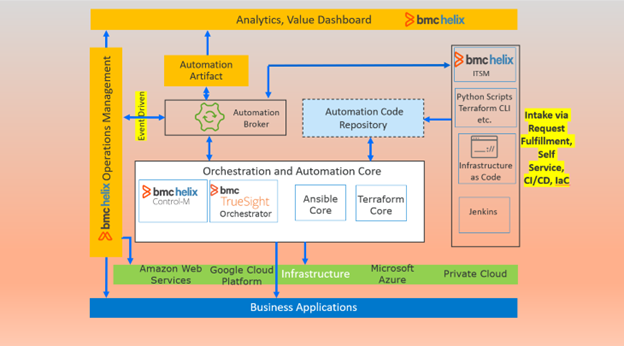In today’s rapidly evolving business landscape, automation plays a vital role in streamlining processes and driving operational efficiency. However, as automation strategies become more complex, organizations often struggle to cope with the expanding workload types, volumes, and locations, leading to a lack of visibility and control. To address these challenges and unlock the full potential of automation, a standardized automation broker framework emerges as a crucial solution. In this blog post, we will explore the concept of an automation broker and how it empowers organizations to achieve a seamless integration, governance, and orchestration of automation workflows.
The need for a unified automation framework
With the increasing adoption of automation, organizations are faced with a sprawling automation landscape, encompassing various tools and systems. This expansion brings forth challenges in automation governance, making it difficult to maintain control and visibility. Balancing the democratization of automation with effective governance becomes crucial for organizations to harness automation’s benefits.
Understanding the automation broker
At the core of solving automation governance challenges lies the concept of an automation broker, which is a software component or platform that acts as a centralized hub, connecting different automation tools, systems, and services. Its primary role is to orchestrate and manage automation workflows, providing a unified interface for executing tasks and ensuring seamless integration.
Core capabilities
An automation broker offers several key capabilities to facilitate effective automation management:
- Workflow automation: Automation brokers enable the creation and management of automated workflows that span multiple applications, both on-premises and in the cloud. These tools provide graphical user interfaces (GUIs) for designing workflows, visualizing interdependencies, and integrating disparate tasks and data sources.
- Event-driven automation: Event-driven automation involves sensing inputs, validating them against configured rules and policies, and taking appropriate actions in response. Automation brokers facilitate the implementation of such sense-and-response workflows, using logic based on “if this, then that” principles.
- Self-service automation: Self-service automation enables users to request and fulfill automation tasks independently. Examples include access requests and guest Wi-Fi, which are typically integrated into IT service management (ITSM) forms. Automation brokers ensure these self-service requests are seamlessly handled and processed.
- Scheduling, monitoring, visibility, and alerting: Automation brokers offer essential components for maintaining visibility and meeting service level agreements (SLAs). They provide monitoring capabilities for tasks, schedules, and alerts, helping organizations proactively identify and address issues and optimize automation processes.
- Resource fulfillment and infrastructure as code: Automation brokers facilitate resource provisioning, allowing organizations to provision compute, network, and storage resources across cloud and on-premises environments. They streamline the process by integrating with multiple adapters or plugins, making resource provisioning efficient and platform-agnostic.
Advantages of an automation broker framework
Implementing an automation broker framework brings several advantages to organizations:
- Automation tool agnosticism: An automation broker eliminates the need for teams to use specific automation tools. As long as an automation tool provides a standard set of APIs, it can seamlessly integrate with the automation broker, enabling flexibility and choice.
- Centralized audit trail and reporting: Automation brokers provide a centralized audit trail for all automation activities, allowing organizations to track and monitor the execution of workflows. This centralization also facilitates the creation of value dashboards that showcase the volume of automations, success rates, and return on investment (ROI) to IT leadership.
- Enhanced governance and risk mitigation: By acting as a centralized hub, an automation broker enables better governance and risk mitigation. It helps identify and mitigate potential issues, preventing buggy codes or scripts from causing catastrophic outages that can impact revenue and reputation.
- Streamlining collaboration and productivity: With an automation broker, organizations can foster collaboration across teams by providing a unified platform for automation. This also eliminates silos and enables teams to share automation assets, best practices, and knowledge, leading to increased productivity and efficiency.
Based on the above points below is a high level illustration of how one can develop an Automation broker Framework. The product and tools mentioned here are purely to explain the concept. Some of these blocks may change based on specific need and requirements for your respective organization but the core concept of unifying automation using the broker will remain the same.

Figure 1: Automation Broker Framework
Developing an effective automation broker framework
Implementing an effective automation broker framework involves considering several key aspects:
- Integration with existing automation tools: Ensure seamless integration with a wide range of automation tools, allowing organizations to leverage their existing investments and tools of choice.
- Scalable architecture and extensibility: Design the automation broker with scalability and extensibility in mind. This ensures it can accommodate future growth, handle increasing automation demands, and integrate with emerging technologies.
- Security and access control measures: Implement robust security measures to protect sensitive data and ensure compliance. Define proper access controls, permissions, and authentication mechanisms to safeguard automation workflows and resources.
- Monitoring and analytics capabilities: Integrate comprehensive monitoring and analytics capabilities into the automation broker, enabling organizations to gain insights, identify bottlenecks, and optimize automation workflows for maximum efficiency.
- Integration with external systems: Enable seamless integration with external systems such as ITSM platforms, ticketing systems, and notification services. This integration enhances automation capabilities and ensures smooth communication and data exchange between the automation broker and these systems.
Conclusion
As organizations strive to become digital-first businesses in an always-on world, a standardized automation broker framework becomes indispensable. By leveraging the power of an automation broker, organizations can establish a unified automation ecosystem, streamline governance, and achieve seamless integration of diverse automation tools and systems. With the ability to orchestrate, manage, and monitor automation workflows, an automation broker empowers organizations to navigate the complexities of automation, unlock its full potential, and thrive in the ever-evolving digital landscape.
These postings are my own and do not necessarily represent BMC's position, strategies, or opinion.
See an error or have a suggestion? Please let us know by emailing blogs@bmc.com.






